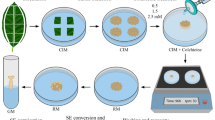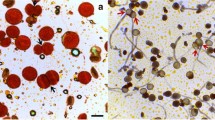Abstract
A multidisciplinary study was carried out to analyse the chromosome doubling process during the early stages of in vitro maize microspore embryogenesis. The main stages (microspore derivatives) that were formed in the course of the culture were analysed. Chromosome number was determined from squashed cells, and DNA content was measured by cytometry. In parallel, an ultrastructural analysis of the microspore derivatives demonstrated the occurrence of a nuclear fusion process. It seems likely that nuclear fusion ensures chromosome doubling at early stages of induced microspore embryogenesis. It occurs precisely at the 5/7 day stage in the embryonic domain and probably leads to polyploidy in the endosperm domain of the microspore derivatives. As a conclusion a scheme summarises the results and proposes an interpretation of the sequence of chromosome doubling events during early maize microspore embryogenesis. Understanding of this process will be important for future efforts to increase the percentage of homozygous plants for crop improvement.





Similar content being viewed by others
References
Antoine-Michard S, Beckert M (1997) Spontaneous versus colchicine-induced chromosome doubling in maize anther culture. Plant Cell Tissue Organ Culture 48:203-207
Barnabas B, Pfahler PL, Kovacs (1991) Direct effect of colchicine on the microspore embryogenesis to produce dihaploid plants in wheat ( Triticum aestivum L.). Theor Appl Genet 81:675-678
Beaumont VH, Widholm JM (1993) Ploidy variation of pronamide-treated maize calli during long term culture. Plant Cell Rep 12:648-651
D’amato F (1984) Role of polyploidy in reproductive organs and tissues. In: Johri BM (ed) Embryology of Angiosperms. Springer-Verlag, New York, pp 519–566
Gaillard A, Vergne P, Beckert M (1991) Optimization of maize microspore isolation and culture conditions for reliable plant regeneration. Plant Cell Rep 10:55–58
Gaillard A, Matthys-Rochon E, Dumas C (1992) Selection of microspore derived embryonic structures in maize related to transformation potential by microinjection. Bot Act 105:313–318
Georgiev S (1987) Cytogenetic studies of the nature of the Sphaerococcum mutation in genus Triticum L. Genet Breed 20:95–100
Ghosh S, Paweletz N (1984) Synchronous DNA synthesis and mitosis in multinucleate cells with one chromosome in each nucleus. Chromosoma 89:197–200
Giménez-Martín G, Risueno MC, López-Saez F (1965) Nuclear fusion in somatic cells: observations with the electron microscope. Fiton 22:173–175
Gomez E, Royo J, Guo Y, Thompson R, Hueros G (2002) Establishment of cereal endosperm expression domains: identification and properties of a maize transfer cell-specific transcription factor, ZmMRP-1. Plant Cell 14:599–610
Gonzàlez-Melendi P, Testillano PS, Ahmadian P, Reyes J, Risueno MC (2000) Immunoelectron microscopy of PCNA as an efficient marker for studying replication times and sites during pollen development. Chromosoma 109:397–409
Goralski G, Lafitte C, Bouazza L, Matthys-Rochon E, Przywara (2002) Influence of sugars on isolated microspore development in maize ( Zea mays L.). Acta Biol Crac 44:203–212
Grafi G, Larkins BA (1995) Endoreduplication in maize endosperm: involvement of M phase-promoting factor inhibition and induction of S phase-related kinases. Science 269:1262–1264
Hansen NJP, Andersen SB (1998) In vitro chromosome doubling with colchicine during microspore culture in wheat ( Triticum aestivum L.). Euphytica 102:101–108
Henry Y (1998) Origin of microspore-derived dihaploid and polyploid in vitro plants. Plant Tissue Culture Biotechnol 4:127–134
Joubès J, Chevalier C (2000) Endoreduplication in higher plants. Plant Mol Biol 43:735–745
Kasha KJ, Hu TC, Oro R, Simion E, Shim YS (2001) Nuclear fusion leads to chromosome doubling during mannitol pretreatment of barley ( Hordeum vulgare L.) microspores. J Exp Bot 52:1227–1238
Lin BY (1977) Ploidy variation in maize endosperm. J Hered 68:143-149
López-Saez F, Risueno MC, Giménez-Martín G (1966) Inhibition of cytokinesis in plant cells. J Ultrastruct Res 14:85–94
Magnard JL, Le Deunff E, Domenech J, Rogowsky PM, Testillano PS, Rougier M, Risueno MC, Vergne P, Dumas C (2000) Genes normally expressed in the endosperm are expressed in early stages of microspore embryogenesis in maize. Plant Mol Biol 44:559–574
Mogensen HL, Leduc N, Matthys-Rochon E, Dumas C (1995) Nuclear DNA amounts in the egg and zygote of maize ( Zea mays L.). Planta 197:641–645
Neuffer MG, Coe EH, Wessler SR (1997) Mutants of maize. Cold Spring Harbor Laboratory Press, New York, p 30
Niebel A, de Almeida Engler J, Hemerly A, Ferreira P, Inzé D, Van Montagu M, Gheysen G (1996) Induction of cdc2a and Cyc1At expression in Arabidopsis thaliana during early phases of nematode-induced feeding cell formation. Plant J 10:1037–1043
Olsen OA, Linnestad C, Nichols SE (1999) Developmental biology of the cereal endosperm. Trends Plant Sci 4:253–257
Risueno MC, Giménez Martín G, López-Saez F (1968) Experimental analysis of plant cytokinesis. Exp Cell Res 49:136-147
Testillano PS, Gonzales-Melendi P, Fadon B, Risueno MC (1995) The immunolocalisation of nuclear antigens during the pollen developmental program and the induction of pollen embryogenesis. Exp Cell Res 221:41–54
Testillano PS, Coronado MJ, Segui JM, Domenech J, Gonzàlez-Melendi P, Raska I, Risueno MC (2000) Defined nuclear changes accompany the reprogramming of the microspore to embryogenesis. J Struct Biol 129:223–232
Testillano PS, Ramirez C, Domenech J, Coronado MJ, Vergne P, Matthys-Rochon E, Risueno MC (2002) Young microspore-derived maize embryos show two domains with defined features also present in zygotic embryogenesis. Int J Dev Biol 46:1035–1047
Traas J, Hülskamp M, Gendreau E, Höfte H (1998) Endoreduplication and development: rule without dividing? Cur Opin Plant Biol 1:498–503
Vergne P, Delvallée I, Dumas C (1987) Rapid assessement of microspore and pollen development stage in wheat and maize using DAPI and membrane permeabilization. Stain Technol 62:299–304
Wan Y, Duncan DR, Rayburn AL, Petolino JF, Widholm JM (1991) The use of antimicrotubule herbicides for the production of double haploid plants from anther derived maize callus. Theor Appl Genet 81:205–211
Wong CK (1989) A new approach to chromosome doubling for haploid rice plants. Theor Appl Genet 77:149–151
Acknowledgements
The authors thank Dr Christian Chevalier (Unité Mixte de Recherche de Physiologie et Biotechnologie Végétales, INRA-Bordeaux) for critically reading the manuscript. They are grateful to Mrs. L.Bouazza, F. Rozier and Mr. H. Leyral for their excellent technical work. This work was partly supported by PAI-Picasso contract (Nr04262VK) in the frame of France/Spain European exchanges.
Author information
Authors and Affiliations
Corresponding author
Additional information
Communicated by G. Almouzni
Rights and permissions
About this article
Cite this article
Testillano, P., Georgiev, S., Mogensen, H.L. et al. Spontaneous chromosome doubling results from nuclear fusion during in vitro maize induced microspore embryogenesis. Chromosoma 112, 342–349 (2004). https://doi.org/10.1007/s00412-004-0279-3
Received:
Revised:
Accepted:
Published:
Issue Date:
DOI: https://doi.org/10.1007/s00412-004-0279-3




